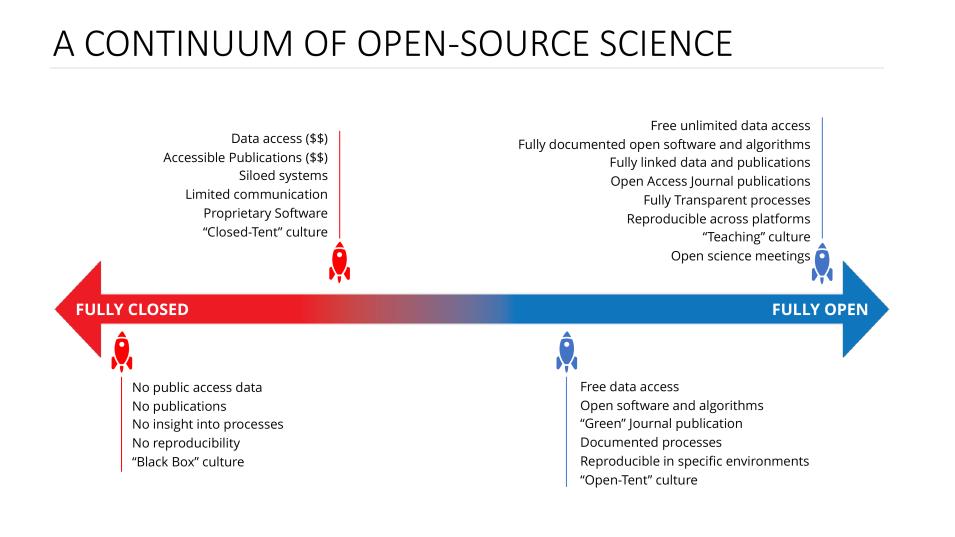The ESDS commitment to open-source data is also predicated on the collaborative use of these data. Through the Earthdata Cloud as well as efforts such as the cloud-based Multi-Mission Algorithm and Analysis Platform (MAAP), ESDS is enabling a broader base of users to interact with these data early in the scientific process. Using a standard internet connection, users in Arizona and Abu Dhabi, for example, can work together to analyze an EOSDIS dataset in real-time without having to download these data.
Open Tools
Along with open data, NASA's ESDS also provides a wide range of tools and applications for working with these data along with the code behind these tools and applications. The Earthdata Data Tools page provides descriptions and links to resources created by EOSDIS Distributed Active Archive Centers (DAACs) for functions such as searching for and subsetting data. In addition, specialized tools such as NASA Worldview and Giovanni enable users to interactively explore hundreds of visualized data layers, overlay multiple layers, do comparisons, create animations, and much more.
Additional resources for using and working with NASA data are listed below.
Algorithm Publication Tool
The Algorithm Publication Tool (APT) developed by NASA's Interagency Implementation and Advanced Concepts Team (IMPACT) enables open, reproducible science by helping scientists write standardized, high-quality algorithm documentation collaboratively. Algorithm Theoretical Basis Documents, or ATBDs, help ensure reproducible science by documenting key scientific assumptions made when writing algorithms and by promoting better understanding of Earth observation data.
Pangeo
The Pangeo project is helping the Earth science community analyze data in the cloud so they can spend less time downloading and managing data. The project is partially funded by NASA's Advancing Collaborative Connections for Earth System Science (ACCESS) Program, which develops technologies to effectively manage, discover, and utilize NASA’s archive of Earth observations for scientific research and applications. Pangeo’s collaborative tools allow researchers to access, process, and analyze NASA data in the commercial cloud without having to download the data. Their ecosystem of interconnected open-source tools use software from Project Jupyter. Project Jupyter software allows users to create and share collaborative workflows in open-source notebooks that contain code, equations, and visualizations.
Multi-Mission Algorithm and Analysis Tool
The Multi-Mission Algorithm and Analysis Tool (MAAP) is a joint effort of NASA and ESA (European Space Agency), and brings together data, algorithms, and computing capabilities in a common cloud environment to facilitate the sharing and processing of data from field, airborne, and satellite measurements. Key features of MAAP are full and open access to mission data through the MAAP Dashboard, the use of open-source code, and unrestricted access to data and ancillary information.
Geographic Information Systems
Geographic Information Systems (GIS) is a collection of computer-based tools for organizing information from a variety of data sources to map and examine changes on Earth. The ESDS vision is to identify and deliver high value Earth science data in formats compliant and compatible with GIS standards; to ensure data are interactive, interoperable, accessible, and GIS-enabled through primary GIS platforms; and to provide the maximum impact to research, education, and public user communities requiring visualization and spatial analysis. The ESDS GIS Team (EGIST) was created to provide sustained program-wide support to enable the appropriate use and adoption of GIS technology in support of Earth science research and applied science for EOSDIS data. Learn more about GIS at NASA.
Providing Open Data for NASA’s Earth System Observatory
NASA’s Earth System Observatory (ESO) is a coordinated series of complementary missions designed to obtain measurements of multiple Earth processes to help address and mitigate climate change. In keeping with NASA’s open data policies, ESO data will be available as early in the mission process as feasible.
Developing a Mission Data Processing System (MDPS) that will ensure the most transparent processing and delivery of ESO mission data is vital. The MDPS is the set of algorithms, software, compute infrastructure, operational procedures, documentation, and teams that process raw instrument data into science quality data products. The MDPS also includes the software tools that support the development of processing algorithms and the validation and analysis of processed data.


